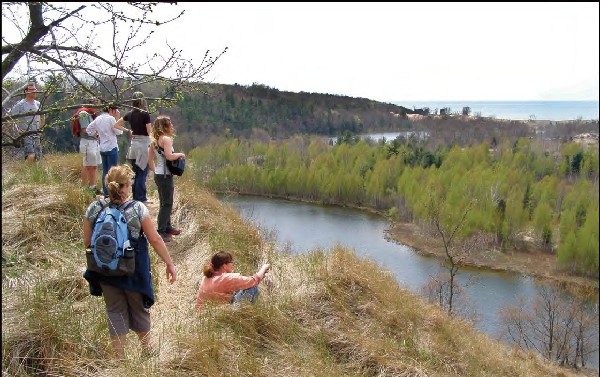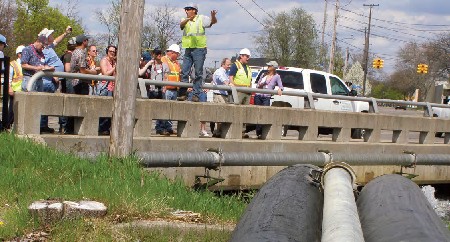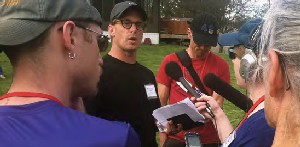SEJournal Online is the digital news magazine of the Society of Environmental Journalists. Learn more about SEJournal Online, including submission, subscription and advertising information.
Feature
By ADAM HINTERTHUER
|
|
|
The group gets a view of the mouth of the Kalamazoo River where it meets Lake Michigan, during a hike on Michigan’s coastal freshwater dunes. Photo: © Adam Hinterthuer, IJNR. |
No self-respecting news organization would employ court reporters who didn’t report from the courtroom, or lead with government coverage from writers who’d never set foot in city hall. Yet, all too often, stories on the complex relationship between economy and ecology are written by journalists who never go out in the field.
Cue the Institutes for Journalism and Natural Resources. Since 1995, IJNR has gotten more than 800 journalists out from behind their desks and into programs that bring them up close to emerging environment issues around North America. And it gets them talking to the industry representatives, government agencies and local citizens working to address those issues.
This year alone, working in collaboration with SEJ, IJNR secured a grant from the Joyce Foundation to run two “institutes” highlighting energy, resource and environment issues in the Great Lakes Basin, plus a scientist/journalist communication workshop. (For more on the latter, see “Changing the Language of Climate Change” in the SEJournal’s Spring 2013 issue.)
One institute this past May saw the latest crop of IJNR “fellows” gathered at Michigan State University’s Kellogg Biological Station north of Kalamazoo. Over four days, the group traversed the length of the Kalamazoo River to learn about everything from Superfund site management, to development on rare coastal freshwater dunes, to a massive spill of Alberta crude on U.S. soil.
For a glimpse of what it’s like to be on an IJNR institute, go ahead and travel with those fellows via the selected logbook-style excerpts below. Plus, check out the tipsheet (see sidebar) on pressing issues and expert sources to dig deeper into these stories or ones in your own watershed.
Wednesday, May 1st — It begins
7:00pm
We’ve been planning this Kalamazoo institute for a year, and as we introduce ourselves at dinner, I’m struck yet again by how dedicated good journalists are to getting at the hard truths buried in complicated stories. Tight deadlines and heavy workloads often stand in the way of comprehensive coverage, but each person here is excited and engaged, ready for four days of doing nothing but digging deeper and learning more.
After dinner, Steve Hamilton, an ecosystem ecologist and professor at Kellogg Biological Station, welcomes us to our four-day tour of what may be “America’s most expensive river.” Between the legacy pollution of polychlorinated biphenyls, or PCBs, from the paper industry and the more recent addition of 800,000- plus barrels of heavy Canadian crude, this river can’t catch a break. Which means we came to the right place.
Thursday, May 2nd — The lasting legacy of Superfund sites
1:38pm
|
|
|
Paul Ruesch, on-scene coordinator for the U.S. EPA’s “time critical” cleanup of Portage Creek, explains the logistics of rerouting the creek (through the black pipes in the foreground) so that contaminated sediment in this section of the creek in downtown Kalamazoo can be removed. Photo: © Adam Hinterthuer, IJNR. |
It’s our first day in the field, and we’re standing on an overpass in downtown Kalamazoo looking at what used to be Portage Creek. A tributary of the Kalamazoo River, it’s now a “time critical” cleanup operation for the U.S. Environmental Protection Agency. The EPA’s on-scene coordinator, Paul Ruesch, is gesticulating and shouting to be heard above the roar of water spilling out of a couple of giant black pipes that are re-routing water around the creek bed, which is currently host to a handful of backhoes digging out sediment contaminated with toxic PCBs. For a project requiring the removal and replacement of an entire creek bed, his energy seems like a great fit for the job.
2:51pm — Landfill full of PCBs
While the sheer invasiveness of the Portage Creek cleanup is remarkable, the more contentious current issue in Kalamazoo involves a less dynamic site.
Plopped down in the middle of the Edison neighborhood is a 45-acre landfill full of PCBs from the defunct Allied Paper, Inc. From our vantage point in the backyard of a home owned by local resident Dick DeVisser, the landfill looks like little more than a gently sloped, grass-covered hill. The only signs of something amiss are the chicken wire surrounding the premises and the thick steel retaining wall following the contours of where the hill meets Portage Creek.
Until 1990, when the EPA slapped the site with Superfund designation, no one quite knew what Allied Paper had left behind. DeVisser tells us that, when he was a kid, he and his “erratically foolish” friends used to walk out on the crust formed by the paper pulp that rose to the surface of retaining lagoons and baked hard in the sun.
The City of Kalamazoo, environmental non-profit groups, and Edison neighborhood residents are all in agreement that “Mount PCB” has to go. The EPA has estimated that would be a $366 million project.
Earlier in the day, Jim Saric, the EPA’s remedial project manager for the entire Kalamazoo River, stressed to us that a final decision hadn’t been made, but Bruce Merchant, director of public services for the city, has been in on discussions with the EPA and indicates they are leaning toward a less expensive (roughly $30 million) “cap and monitor” option.
Merchant tells us that’s not good enough. Without removal, the city will never be able to redevelop those 45 acres. What’s more, the site sits on top of an aquifer that supplies Kalamazoo with drinking water. That makes officials uneasy. There’s a man named Murphy with a famous law – if the seal should ever buck expectations, even decades from now, the city would, once again, be mired in a toxic legacy.
Both sides are now exploring a $120 million proposal from Michigan’s only landfill licensed to hold PCBs in hopes it can split the difference and put the Allied issue to rest.
Friday, May 3rd — The biggest oil spill you never heard of
8:39am
The EPA’s Incident Command Center for the Enbridge oil spill is an austere place – an office building where no one bothered to decorate on the assumption that they’d be setting up shop for only a few months.
Ralph Dollhopf, who has served as the federal on-scene coordinator and incident commander for the biggest oil spill ever on American soil, tells us that now, three years later, his crews have entered “q-tip mode,” foregoing the vacuum trucks and power washers that dominated the initial response to the spill.
Since it occurred during BP’s big fiasco in the Gulf, this spill near Marshall received relatively scant media attention. We’re hoping our visit can help jumpstart a few new stories.
While Dollhopf is candid when talking about the sheer magnitude of the cleanup itself, he’s not willing to go much further. The EPA once issued estimates of the spill that were more than 200,000 barrels higher than Enbridge’s assessment of what the Canadian oil pipeline company and the EPA call “the discharge.”
That’s not an unimportant number, since the amount Enbridge ultimately pays in fines is tied to it. Recently, though, the EPA lowered its estimate. Dollhopf declines to comment on that and waves off a softball follow up simply asking who is involved in setting that final number.
Dollhopf does concede the Kalamazoo response wrote the script for how to handle future spills of this new crude. No one expected it to sink to the bottom of the river. Thanks, in part, to Enbridge’s insistence in the first several days that the oil was “regular” crude, the EPA’s initial response was to deploy surface skimmers and floating booms. While those collected a lot of oil, they missed a substantial amount that sank into the river bottom.
11:35am — Looking for the sheen
Late morning and we’re a drifting flotilla of canoes and kayaks, seeing for ourselves what a river can look like three years after a major oil spill.
Our journalists are snapping pictures of faint oil rings left on shoreline trees and prodding the river bottom with paddles in hopes of seeing a sheen billow up, but the river appears, overall, to be in good health. An article referencing “environmental devastation” would be way off base. We see a nesting sandhill crane and startle muskrats and blue herons plying the shallow waters along the shore.
While scientists are still trying to assess the impacts the sinking crude had on the bottom-dwelling insects that form the base of the Kalamazoo food web, Steve Hamilton tells us the lasting environmental impact is not as severe as was initially feared. In fact, this section of the Kalamazoo is in far better shape than the area lined with Superfund sites downstream.
Despite the relatively clean bill of health, we learn that oil sheens are a deal-breaker for the EPA. Small sheens continue to pop up in the reservoirs and pools behind dams, and Enbridge was summarily ordered to re-dredge several sites on the river.
4:45pm — Backyard pipeline
A line of colored flags stretches off into the distance on one side of Dave and Karin Gallagher’s backyard. On the other, it runs smack dab into a stand of mature spruce trees Karin planted when she was a kid. Soon, everything in the path of these flags will be dug up so Enbridge can lay Line 6B replacement pipe, a state-ofthe-art pipeline that will be a far safer means of carrying oilsands crude than the four-decades-old pipe that ruptured in 2010.
Gallagher admits to our group that he knew there was an easement on the property when he bought the home. Of course knowing that and envisioning a future where a pipeline carrying millions of barrels of oil a day would be installed seven feet from his back porch is another matter.
What’s more, he’s incensed by the way Enbridge has conducted business with him, saying they’ve been curt and unresponsive, offering $6,400 to agree to the plan via a letter from their lawyers, with the caveat that, should he refuse, eminent domain will enter the picture.
|
|
|
Jeff Insko talks about his experience as a homeowner on the Line 6B replacement pipeline route. New pipe has already been laid on Insko’s property and the experience led him to create the Line 6B Citizen’s Blog to provide information and support to other homeowners dissatisfied with the project. Photo: © Adam Hinterthuer, IJNR. |
The Line 6B replacement isn’t a replacement in the true sense of the word. The old pipe will be taken off line, but stay in the ground. But, by calling it a replacement pipe, we learn, Enbridge is able to build a new, higher-capacity pipeline to transport Canadian crude across Michigan without the presidential permit process that its competitor, TransCanada, is currently dealing with for Keystone XL. The pipeline will hook up to refineries in northern Indiana and reach ports on the Great Lakes.
Keystone or no Keystone, some company is going to get Canadian crude through U.S. pipelines and out to international markets.
Saturday, May 4th — Connecting the dots
3:30pm
We’re capping off the institute with a conversation about development on Lake Michigan’s freshwater coastal dunes. We’ve chartered the Star of Saugatuck for a private cruise and given our journalists two excellent (and captive!) sources – Jon Allan, who directs the Office of the Great Lakes for the Michigan Department of Environmental Quality, and former state senator and legislator Patty Birkholz, a force for conservation in Michigan.
Access to sources like these is a cornerstone of an IJNR institute and it’s good to see our group get to lob questions to their heart’s content. At one point, Allan turns the tables, snatches the microphone out of WMUK reporter Rebecca Thiele’s hands, and uses it for an ambush interview of Associated Press reporter John Flesher. It’s a nice moment of levity after a day hearing about a development plan that has dragged the community into several years’ worth of lawsuits and accusations.
As we head out the mouth of the Kalamazoo River and into Lake Michigan, I’m struck by the connectedness of everything we’ve seen on the trip. The Portage Creek cleanup and Kalamazoo oil spill and development along the shoreline of this amazing inland sea are all part of the same watershed and all have implications for the communities depending on the health of the river for their industrial operations, their drinking water, their canoe rental outfit, their weekend fishing trips, their shoreline tourist destinations, and, perhaps most important, their fantastic beer!
Soon we’ll head back to the dock and maybe even let our journalists play tourist for an hour, then it’s off to our closing dinner and on to planning our next trip.
Adam Hinterthuer is director of programs for the Institutes for Journalism and Natural Resources. He also serves as the outreach specialist for the University of Wisconsin, Madison’s Center for Limnology (the study of lakes, basically). Adam lives in Madison with his wife, Carrie, and their two daughters. He received his master’s degree in journalism from the University of Wisconsin School of Journalism and has a bachelor’s degree from Carleton College in Northfield, Minn.
* From the quarterly newsletter SEJournal, Summer 2013. Each new issue of SEJournal is available to members and subscribers only; find subscription information here or learn how to join SEJ. Past issues are archived for the public here.















 Advertisement
Advertisement 



